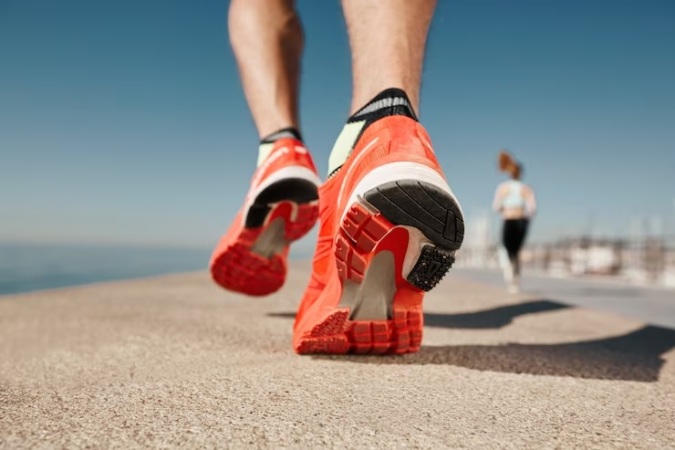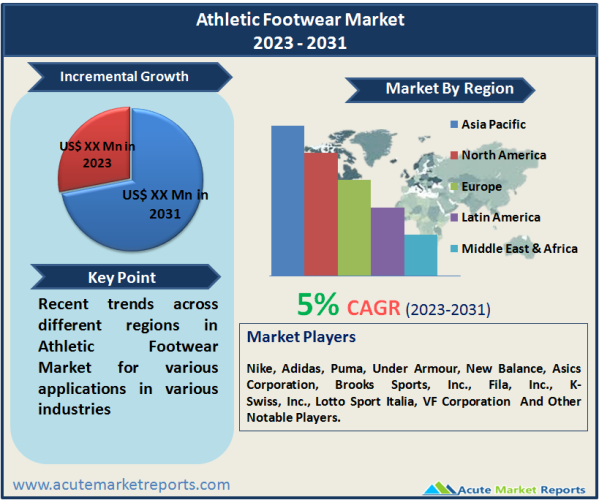
The athletic footwear market is expected to grow at a CAGR of 5% during the forecast period of 2024 to 2032. It encompasses a wide range of footwear designed specifically for sports and physical activities. One of the primary drivers of the athletic footwear market is the increasing awareness of health and fitness among individuals worldwide. With the rising prevalence of lifestyle-related diseases such as obesity and diabetes, people are becoming more conscious of the importance of regular physical activity. This awareness has translated into a significant demand for athletic footwear across various age groups and demographics. The surge in the sale of running shoes, walking shoes, and sports shoes in recent years. In 2023, these segments collectively accounted for a substantial share of the market's revenue. Additionally, numerous fitness trends and activities like jogging, walking, and gym workouts have gained popularity, further boosting the demand for specialized athletic footwear. The athletic footwear market is poised for continued growth, driven by factors such as health and fitness awareness, the athleisure fashion trend, and technological advancements. Despite challenges related to rising raw material costs and supply chain disruptions, the market is expected to expand further across different types and end-users, with varying geographic trends. Leading players will continue to compete aggressively, utilizing key strategies to maintain their positions in this competitive landscape.

Athleisure Fashion Trend
Another key driver of the athletic footwear market is the athleisure fashion trend. Athleisure refers to the fusion of athletic wear with everyday fashion, creating a comfortable and stylish look that can be worn both during exercise and in casual settings. This trend has revolutionized the athletic footwear industry, as consumers seek not only performance but also aesthetics in their footwear. Evidently, major athletic footwear brands have capitalized on this trend by designing sneakers and sports shoes that are not only functional but also stylish. Brands like Nike, Adidas, and Puma have launched fashionable athletic shoe collections that have resonated with consumers. This has contributed significantly to the revenue growth of these brands and the overall market.
Technological Advancements
Technological advancements in athletic footwear have played a pivotal role in driving the market forward. Innovations such as cushioning technologies, breathable materials, and enhanced sole designs have greatly improved the comfort and performance of athletic shoes. These advancements have not only attracted professional athletes but also everyday fitness enthusiasts. For instance, the incorporation of responsive cushioning materials like Nike's Air Zoom and Adidas' Boost technology has enhanced shock absorption and energy return, making athletic shoes more comfortable for long-term wear. Additionally, the integration of smart technologies, such as fitness tracking sensors, has created a niche market for connected athletic footwear.
Rising Raw Material Costs and Supply Chain Disruptions
While the athletic footwear market is experiencing growth, it is not without its challenges. One significant restraint is the rising costs of raw materials and frequent disruptions in the global supply chain. These factors have led to increased production costs and supply chain inefficiencies, ultimately impacting profit margins for footwear manufacturers. The prices of key raw materials like rubber, leather, and synthetic materials have been steadily increasing. These cost escalations are often passed on to consumers, resulting in higher retail prices for athletic footwear. Moreover, the COVID-19 pandemic exacerbated these issues, causing supply chain disruptions and delays in production, further straining the industry's ability to meet demand effectively.
Market Segmentation by Type (Aerobic Shoes, Running Shoes, Walking Shoes, Trekking & Hiking Shoes, Sports Shoes) – Sports Shoes Dominated the Segment
The athletic footwear market is segmented by type into several categories, each catering to specific activities and consumer preferences. Among these, sports shoes emerged as the highest revenue generator in 2023, driven by their versatility and appeal to a wide range of athletes and enthusiasts. Running shoes, in particular, witnessed a surge in demand, owing to the growing popularity of running as a fitness activity. In terms of the highest CAGR during the forecast period from 2024 to 2032, trekking and hiking shoes are expected to experience significant growth. The increasing interest in outdoor activities and adventure tourism is anticipated to boost the demand for these specialized footwear options, especially among adventure enthusiasts.
Market Segmentation by End-user (Men, Women, Children) - men's athletic footwear Dominates in terms of Revenues.
The market segmentation by end-users highlights the diverse consumer base of athletic footwear. In 2023, men's athletic footwear accounted for the highest revenue share, driven by men's participation in various sports and fitness activities. Women's athletic footwear also constituted a substantial portion of the market, reflecting the growing female participation in sports and fitness. However, the highest CAGR during the forecast period of 2024 to 2032 is projected for children's athletic footwear. The increasing awareness of childhood obesity and the promotion of physical activity among children are expected to drive the demand for specialized athletic shoes tailored to their needs.
APAC to Present Significant Opportunities during the Forecast Period
The athletic footwear market exhibits distinct geographic trends, with varying levels of demand and growth rates across regions. North America and Europe have historically been key markets for athletic footwear due to their strong sports culture and fitness-conscious populations. In 2023, North America led in terms of revenue, driven by the United States' significant market share. However, the Asia-Pacific region is expected to exhibit the highest CAGR during the forecast period from 2024 to 2032. Emerging economies such as China and India have witnessed a surge in fitness consciousness, urbanization, and disposable income, leading to increased spending on athletic footwear. This shift in consumer behavior is expected to drive substantial growth in the Asia-Pacific market. Additionally, Latin America and the Middle East & Africa regions are also expected to witness moderate growth during this period, albeit from a smaller market base.
Market Competition to Intensify during the Forecast Period
The athletic footwear market is highly competitive, with several key players vying for market share. In 2023, top players such as Nike, Adidas, Puma, Under Armour, New Balance, Asics Corporation, Brooks Sports, Inc., Fila, Inc., K-Swiss, Inc., Lotto Sport Italia and VF Corporation dominated the market, collectively accounting for a significant portion of the industry's revenue. These leading companies have employed various strategies to maintain their competitive edge. They have invested heavily in research and development to introduce innovative products, collaborated with athletes and celebrities for endorsements and brand promotion, and expanded their e-commerce presence to reach a broader customer base. As expected, these players are anticipated to continue their strategies in the forecast period from 2024 to 2032. However, the market may also witness the emergence of niche and innovative brands offering specialized athletic footwear, catering to specific sports and activities.
Historical & Forecast Period
This study report represents analysis of each segment from 2022 to 2032 considering 2023 as the base year. Compounded Annual Growth Rate (CAGR) for each of the respective segments estimated for the forecast period of 2024 to 2032.
The current report comprises of quantitative market estimations for each micro market for every geographical region and qualitative market analysis such as micro and macro environment analysis, market trends, competitive intelligence, segment analysis, porters five force model, top winning strategies, top investment markets, emerging trends and technological analysis, case studies, strategic conclusions and recommendations and other key market insights.
Research Methodology
The complete research study was conducted in three phases, namely: secondary research, primary research, and expert panel review. key data point that enables the estimation of Athletic Footwear market are as follows:
Market forecast was performed through proprietary software that analyzes various qualitative and quantitative factors. Growth rate and CAGR were estimated through intensive secondary and primary research. Data triangulation across various data points provides accuracy across various analyzed market segments in the report. Application of both top down and bottom-up approach for validation of market estimation assures logical, methodical and mathematical consistency of the quantitative data.
| ATTRIBUTE | DETAILS |
|---|---|
| Research Period | 2022-2032 |
| Base Year | 2023 |
| Forecast Period | 2024-2032 |
| Historical Year | 2022 |
| Unit | USD Million |
| Segmentation | |
Type
| |
End-User
| |
|
Region Segment (2022-2032; US$ Million)
|
Key questions answered in this report